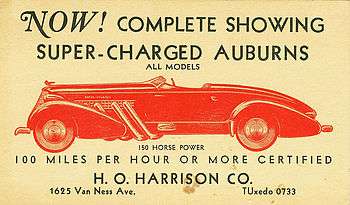Auburn Automobile
|
Auburn hood ornament | |
| Industry | Automotive |
|---|---|
| Fate | Bankruptcy |
| Predecessor | Eckhart Carriage Company |
| Founded | 1900 in Auburn, Indiana |
| Founder | Frank and Morris Eckhart |
| Defunct | 1937 |
| Headquarters | Auburn, Indiana, United States |
Area served | United States |
Key people |
Frank and Morris Eckhart E.L. Cord |
| Products |
Automobiles Automotive parts |
Auburn was a brand name of American automobiles produced from 1900 through 1937.
Corporate history
The Auburn Automobile Company grew out of the Eckhart Carriage Company, founded in Auburn, Indiana, in 1874 by Charles Eckhart (1841–1915).[1] Eckhart's sons, Frank and Morris, experimented making automobiles before entering the business in earnest, absorbing two other local carmakers and moving into a larger plant in 1909. The enterprise was modestly successful until materials shortages during World War I forced the plant to close.
In 1919, the Eckhart brothers sold the company to a group of Chicago investors headed by Ralph Austin Bard, who later served as Assistant Secretary of the Navy for President Franklin Delano Roosevelt and as Undersecretary of the Navy for President Roosevelt and for President Harry S. Truman. The new owners revived the business but failed to realize their anticipated profits and in 1924, approached Errett Lobban Cord (1894–1974), a highly successful automobile salesman, with an offer to run the company. Cord countered with an offer to take over completely in what amounted to a leveraged buyout and the Chicago group accepted. Cord aggressively marketed the company's unsold inventory and completed his buyout before the end of 1925.
But styling and engineering failed to overcome the fact that Cord's vehicles were too expensive for the Depression-era market and Cord's stock manipulations that would force him to give up control of his car companies. Under injunction from the U.S. Securities and Exchange Commission to refrain from further violations, Cord sold his shares in his automobile holding company. In 1937, production of Auburns, along with that of Cords and Duesenbergs, ended.

Models
The 1904 Auburn was a touring car model. Equipped with a tonneau, it could seat two or four passengers and sold for US$1000. The flat-mounted single-cylinder engine, situated at the center of the car, produced 10 hp (7.5 kW). A two-speed planetary transmission was fitted. The angle-steel-framed car weighed 1,500 lb (680 kg) and used half-elliptic springs.[2]
In 1926, Cord, now the owner of Auburn, partnered with Duesenberg Corporation, famous for its racing cars, and used it as the launching platform for a line of high-priced luxury vehicles. He also put his own name on a front-wheel-drive car, the Cord, later referred to as "L-29".
Employing imaginative designers such as Alan Leamy — chief designer of the 1933 Auburn Speedster, and Gordon Buehrig, who modified leftover bodies to produce the 1935 851 Speedster and modified the four-door,[3] Cord built cars such as the Duesenberg Model J (1928–37), the Auburn Speedster (1935–37), and the Cord 810/812 (1936–37) that became famous for their advanced engineering as well as their striking appearance. The Auburn Boattail Speedster was powered by a 4.6L straight eight that, with the popular supercharger option (150 hp), could top 100 mph (160 km/h) making it a popular model in the Hollywood market.[4]
The Depression, coupled with Cord's stock manipulations, spelled the end of the company and production ceased in 1937. The company's art deco headquarters in Auburn now houses the Auburn Cord Duesenberg Automobile Museum and became a National Historic Landmark in 2005. The Auburn Automobile Company also had a manufacturing plant in Connersville, Indiana, formerly owned by the Lexington Motor Company.
Auburn production specifications
See also

References
- ↑ "Motor Body, Paint and Trim". The Carriage Monthly. XL (1): 167. April 1904. Retrieved 2014-07-14.
- ↑ Frank Leslie's Popular Monthly. LVII, No.3. January 1904. p. 369. Retrieved 2014-07-14.
- ↑ Buehrig, Gordon M.; Jackson, William S. (1975). Rolling Sculpture: A Designer and his Work. Newfoundland, NJ: Haessner Publishing Inc. pp. 66–72. ISBN 978-0877990451.
- ↑ "6 Super Charged Models". Oldcarbrochures.com. 1934. Retrieved 2014-07-14.
- Auburn & Cord by Lee Beck and Josh Malks (1996) ISBN 978-0760301722
- Auburn Cord Duesenberg by Don Butler (1992) ISBN 978-0879387013
External links
| Wikimedia Commons has media related to Auburn vehicles. |
- Auburn-Cord-Dusenberg Club Official Website
- Auburn-Cord-Dusenberg Flickr Group
- The Auburn Gallery at White Glove Collection
- RemarkableCars.com- Auburn Photo Galleries